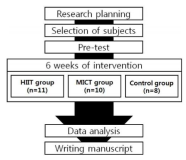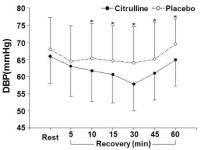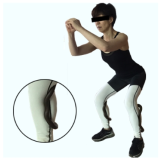PURPOSE This study explores the impact of visual shape and exercise involvement on consumers' evaluation and happiness with healthy functional foods, specifically protein cookies. METHODS Using a one-factor design with two levels (pretty vs. ugly shape) and one measured variable (exercise involvement), we uncover interesting insights. RESULTS Consumers highly engaged in exercise show a greater purchase intention for ugly-shaped healthy functional foods compared to pretty-shaped ones. Conversely, consumers with low exercise involvement express a higher purchase intention and happiness when it comes to pretty-shaped healthy functional foods compared to their ugly counterparts. CONCLUSIONS These findings contribute to the sports management and sports science literature by shedding light on how visual shape influences the evaluation of healthy functional foods by sport consumers. Furthermore, this research offers valuable practical implications for designing the shape of such foods to cater to the preferences of sports enthusiasts.
PURPOSE The purpose of this study was to investigate the effects of 8-week aerobic exercise and polyphenol intake on body composition, cardiovascular response, vascular endothelial function, and physical fitness at rest and during exercise in prehypertensive men. METHODS The study included twenty-eight males in their 20-30 years of age with prehypertension. Participants in the aerobic exercise + polyphenol intake group (EX + PP; n = 14) performed aerobic exercise three sessions/week, 30 min/session, at 65% of the heart rate reserve, and consumed polyphenol (grape seed extract 300 mg) for 8 weeks. Participants in the aerobic exercise + placebo intake group (EX + PL; n = 14) performed the same aerobic exercise; however, they consumed placebo instead of polyphenol. All independent variables were measured at pre-test and post-test, and the data were analyzed. RESULTS The main results of the study were as follows: 1) SBP and MAP at rest decreased significantly in EX + PP, while MAP decreased significantly in EX + PL group. 2) In the EX + PP group, CO increased significantly, whereas DBP, MAP, and TPR decreased significantly during the hand grip exercise. In contrast, CO decreased significantly, while DBP and TPR increased significantly in the EX + PL group during the hand grip exercise. 3) Regarding vascular endothelial function, % FMD increased significantly in EX + PP group. 4) Sit-up increased significantly in both EX + PP and EX + PL groups; however, sit-and-reach in EX + PP group was significantly higher than that in EX + PL group at post-test. CONCLUSIONS The findings of this study showed that the 8-week aerobic exercise would have positive effects on body composition, cardiovascular response, and physical fitness at rest and during exercise in hypertensive men. Additionally, polyphenol intake would contribute more towards reduction of blood pressure at rest and during exercise and improvement of vascular endothelial function.

The primary purpose of this study was to investigate the effects of 6 weeks of high-intensity intermittent training (HIIT) and moderate-intensity continuous training (MICT) under relatively equal energy expenditure on body composition, aerobic capacity, cardiovascular function, insulin resistance, and blood lipid profiles in 20s overweight males. Twenty-nine males were randomized into one of the following groups: HIIT group (n=11), MICT group (n=10), and control group(n=8). Subjects in HIIT group completed 6 weeks of training for 25 min/sessions, three times/wk, and subjects in MICT group exercised for 33 min/session to equalize the energy expenditure with HIIT group. Subjects in control group were asked to maintain their normal life pattern during the same intervention period. Data were analyzed using two-way repeated measures ANOVA with post hoc test. Main results of the present study were as follows: 1) Body weight, BMI, fat mass, and WHR decreased significantly in HIIT group. 2) VO2max, VEmax, and time to exhaustion increased significantly in HIT group. 3) SBP decreased significantly in HIIT group and HRrest was tended to decrease in HIIT. 4) Fasting plasma insulin and HOMA-IR were tended to decrease in HIIT, but the changes failed to reach the statistically significant level. 5) HDL-C and TG were tended to improve in HIIT, but the changes failed to reach the statistically significant level. Results indicate that high intensity intermittent exercise training is more beneficial in aerobic capacity and cardiovascular function. It was also suggested that 6 weeks of aerobic exercise training in either high intensity intermittent or moderate intensity continuous was not sufficient enough to induce changes in body composition, insulin resistance and blood lipid profiles.

Purpose The purpose of this study was to investigate the effect of a 10-week aerobic exercise training on cardiovascular function, atherosclerosis, and vascular endothelial function in elderly women. Methods Twenty impaired fasting glucose (IFG) and normoglycemic elderly women volunteered to participate in the study. The participants in aerobic exercise training group (TR: n=9) completed 20-40 minutes of aerobic exercise program at 30-50% HRR for 3 times per week during 10 weeks. The participants in control group (CON: n=11) were asked to maintain their normal life pattern during the same intervention period. Results Main results of the study were as follows: 1) There were no significant main effect or interaction in body weight, fat-free mass, fat mass, percent body fat, and body mass index. 2) There were no significant main effect or interaction in heart rate, stroke volume, cardiac output, total peripheral resistance (TPR), systolic blood pressure, diastolic blood pressure, mean arterial blood pressure, pulse pressure, and rate pressure product. However, interaction between group and test in TPR was close to statistically significant level (P =.054), and it tended to be decreased in TR group. 3) There was a significant main effect of test in high sensitivity C-reactive protein(hs-CRP), it tended to be decreased in TR group. There were no significant changes in total cholesterol(TC)/high density lipoprotein-cholesterol (HDL-C) ratio, triglyceride/HDL-C ratio, and low density lipoprotein-cholesterol/HDL-C ratio. 4) There were significant main effect of group, main effect of test, as well as interaction between group and test in % flow mediated dilation(FMD), and it increased significantly (P<.01) in TR group. Nitric oxide tended to be increased in TR group, even though it did not change significantly in both groups. Conclusions It was concluded that the 10-week aerobic exercise training would be beneficial for improvement of vascular endothelial function, resulting from the decrement of total peripheral resistance.

It has well known that post-exercise hypotension (PEH) after a bout of aerobic exercise was a major mechanism to reduce blood pressure though exercise training, and that citrulline supplementation reduced blood pressure by increasing nitric oxide in vivo. However, the effects of citrulline supplementation on PEH have not been fully elucidated yet. This study was designed to examine the effects of citrulline supplementation on PEH after a bout of aerobic exercise in prehypertensive and normotensive 20s males. The effects of a four-day citrulline or placebo treatment on blood pressure, cardiovascular function, and blood lactate concentration measured at rest and during recovery phase after a bout of exercise performed for 30 min at 70% VO2max were compared and analyzed. All subjects participated in a citrulline trial and a placebo trial repeatedly according to a counter-balanced order. Main results of the present study were as follows: 1) Systolic blood pressure, diastolic blood pressure, and mean arterial pressure measured at 10-60 min of recovery phase in citrulline trial were significantly lower than placebo trial. Rate-pressure product measured at 30 min and 45 min of the recovery phase in citrulline trial was significantly lower than placebo trial. 2) No significant differences were found in heart rate (HR), cardiac output (CO), and total peripheral resistance (TPR) measured during the recovery phase between two trials. There were significant differences in HR, stroke volume, CO, and TPR among times within a trial. 3) No significant difference was found in blood lactate concentration measured at rest and during the recovery phase between two trials. The results would be summarized that the PEH was augmented by the citrulline supplementation, and that burden to cardiac muscle as well as cardiovascular function were not affected by the citrulline supplementation. It was concluded that the short-term citrulline supplementation would be very effective to augment the PEH. A research investigating the effects of citrulline supplementation on the PEH in pre-hypertensive and/or hypertensive individuals would be warranted. In addition, a study examining the effects of citrulline supplementation during long-term exercise training on the blood pressure in hypertensive patients also would be warranted in near future.


PURPOSE Blood pressure (BP) in hypertensive individuals is reduced by the accumulation of post-exercise hypotension (PEH) induced by a long period of training. This study aimed to investigate the effects of intensity of two different aerobic exercises with identical energy expenditure on post-exercise blood pressure and cardiovascular function in prehypertensive men. METHODS Eleven prehypertensive men in their 30s participated in two trials repeatedly. In the first trial, the exercise was moderate in intensity and continuous (MICE) with 70% of VO2max, and the exercise in the second trial was high-intensity interval exercise (HIIE) with 50% and 90% of VO2max. Each exercise was performed for 30 min, and the variables related to BP and cardiovascular function were measured at certain times for 1 hr during the recovery phase. RESULTS Our main findings are as follows: (1) Systolic blood pressure was significantly lower at 30 and 45 min of recovery time than the baseline in the HIIE trial, and systolic blood pressure was significantly lower in the HIIE trial than the MICE trial at 10, 15, and 30 min of recovery time. (2) The rate pressure product was significantly higher in the HIIE trial than the MICE trial at 15, 30, 45, and 60 min of recovery time. (3) The heart rate was significantly higher in the HIIE trial than the MICE trial at 15, 30, 45, and 60 min of recovery time. (4) Stroke volume was significantly lower in the HIIE trial than the MICE trial at 30 min of recovery time. (5) Cardiac output was significantly higher in the HIIE trial than the MICE trial at 15 min of recovery phase. (6) Total vascular conductance was significantly higher in the HIIE trial than the MICE trial at 15 and 30 min of recovery phase. (7) Total peripheral resistance was significantly lower in the HIIE trial than the MICE trial at 15 and 30 min of recovery phase. CONCLUSIONS The HIIE shows a higher cardiovascular stress than MICE; however, HIIE contributes to the augmentation of PEH and improvement of cardiovascular function. Therefore, HIIE rather than MICE should be suggested in BP control and enhancement of cardiovascular function in prehypertensive males.
Purpose This study was designed to examine the effects of 8 weeks of circuit exercise training on blood lipids, insulin resistance, cardiovascular function, and metabolic syndrome risk factors in 40~50s male bus drivers. Methods Twenty-nine bus drivers were randomly assigned to one of two groups, i.e., circuit exercise training group (TR: n=14) and control group (CON: n=15). Subjects in TR participated in circuit exercise training 30-40 min per session, three sessions per week for 8 weeks, whereas subjects in CON were asked to maintain their normal life pattern for same intervention period. The variables regarding body composition, blood lipids, insulin resistance, cardiovascular function, and number of metabolic syndrome risk factors were measured and compared between two groups as well as between pre- and post-test. Data were analyzed using repeated two-way ANOVA with post hoc test. Results Main results of the present study were as follows: 1) Waist circumference, waist-hip ratio, body mass index, and percent body fat decreased significantly in TR. 2) LDL-C decreased and HDL-C increased significantly in TR. 3) Fasting plasma insulin and HOMA-IR decreased significantly in TR. 4) Regarding cardiovascular function, diastolic blood pressure and mean arterial pressure decreased significantly in both TR and CON. hs-CRP were not changed significantly; however, it tended to be decreased TR. 5) Number of metabolic syndrome risk factors decreased significantly in TR(2.86±0.86 to 1.50±0.76). Conclusions It was concluded that 8 weeks of circuit exercise training would be beneficial for improvement of blood lipid profiles and insulin resistance, resulting in preventing metabolic syndrome. In particular, it would be very clinically meaningful that number of metabolic syndrome risk factors decreased from 2.86±0.86 to 1.50±0.76 by the circuit exercise training.
The primary purpose of the study was to compare cardiovascular function, mental health indices, stress-related variables according to body mass index (BMI) and percent body fat (%BF) in 20s females. Sixty-eight women, aged 20-29 yrs, participated in the study as subjects. There were three groups, i.e., normal group (BMI<24 kg·m-2 and %BF<25%; n=25), normal weight obese group (BMI<24 kg·m-2 and 28%<%BF<40%; n=19), and obese group (BMI>26 kg·m-2 and 28%<%BF<40%; n=24). Cardiovascular function, mental health indices, stress-related blood variables were measured and compared among three groups. Main results of the present study were as follows: 1) SBP, DBP, mean arterial pressure, and RPP were significantly higher in obese group than normal group. 2) There were no significant differences in mental health indices among three groups. 3) Fasting plasma insulin, fasting plasma glucose, and CRP were significantly higher in obese group than normal weight obese group and normal group. It was concluded that there would be abnormal cardiovascular function, insulin resistance, and inflammation in general obese individuals in 20s females, not normal weight obese and normal individuals.
PURPOSE This study aimed to investigate how a 10-week online live Pilates training held during the COVID-19 pandemic affected body composition, cardiovascular function, and physical fitness in sedentary middle-aged obese women. METHODS Thirty obese women, aged 30 to 49 years (BMI : 25kg/m2 or more; waist circumference: 85cm or more) who were leading a sedentary lifestyle for more than 8 hours a day were assigned to one of two groups—that is, the Pilates training group (TR) and the control group (CON). Four participants were dropped from the study during the intervention period. Participants in the TR group (n=13) performed online live mat Pilates exercises (3 sessions per week; 60 minutes per session for 10 weeks, whereas participants in the CON group (n=13) were asked to maintain their normal lifestyles during the same intervention period. Independent variables related to body composition, cardiovascular function, venous function in the lower body, physical fitness, and 1-RM (repetition maximum) were measured at pre-test and post-test, and data were compared between the two groups and between the two tests. RESULTS 1) Regarding body composition, body weight, body mass index, fat mass, and waist circumference decreased significantly in the TR group. 2) Regarding cardiovascular function, stroke volume and cardiac output increased significantly in the TR group, and total peripheral resistance decreased significantly in the TR group. 3) Regarding venous function in the lower body, blood flow velocity and blood flow volume of the parenchyma area increased significantly in the TR group. 4) Regarding physical fitness, cardiorespiratory endurance, muscular endurance, flexibility, and balance improved significantly in the TR group. 5) 1RM of biceps curl, lat pull-down, leg curl, and leg extension increased significantly in the TR group. CONCLUSIONS It was concluded that the 10-week online live Pilates training had positive effects on the body composition, cardiovascular function, venous function in the lower body, and physical fitness of middle-aged obese women leading sedentary lifestyles.

Purpose This study was designed to investigate the effects of weight-bearing exercise and CareRing treatment on cardiovascular responses, popliteal vein functions, and vascular elasticity of 30-40s women who had worked longer than eight hours a day in a standing position. Methods Thirteen subjects participated in 30 min of standing up treatment (STAND), weight-bearing exercise treatment (EX), and weight-bearing exercise with CareRing treatment (EX+RING). Each subject took part in the three trials repeatedly in a counter-balanced order and proceeded with a wash-out period of at least one week between the respective trials. Results The main results were as follows: 1) Significant reduction in EDV, no change in the diameter of popliteal vein, trend of reduction in blood flow of popliteal vein, and increased baPWV, indicating reduction of vascular elasticity of whole body, were shown in the STAND. 2) CO and EF increased significantly, and TPR decreased significantly in the EX. Blood flow velocity and blood flow volume of popliteal vein increased significantly, and baPWV decreased significantly from immediately after the treatment throughout the recovery phase in the EX. 3) HR, CO, and EF increased significantly in the EX+RING. Blood flow velocity and blood flow volume increased significantly in the EX+RING. Diameter of popliteal vein increased significantly immediately after the treatment and decreased significantly at 40 minutes of recovery. TPR and baPWV decreased significantly immediately after treatment compared to the STAND. Conclusions It was concluded that weight-bearing exercises would be effective in preventing venous or cardiovascular diseases occurred due to long-standing in 30-40s women, who are at high risk for such diseases. Furthermore, it would be more effective to combine pressure treatment with CareRing during weight-bearing exercises.
